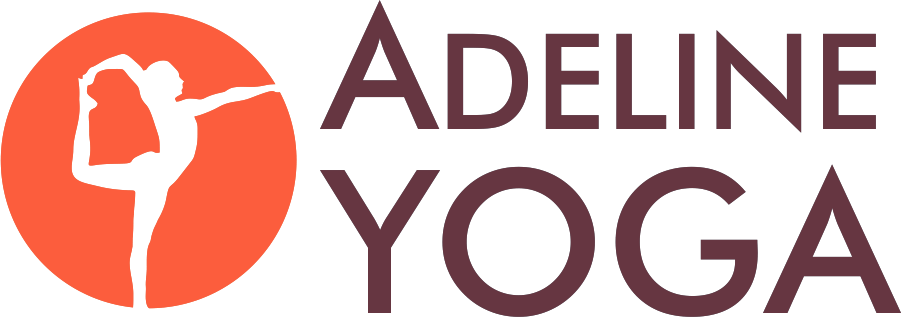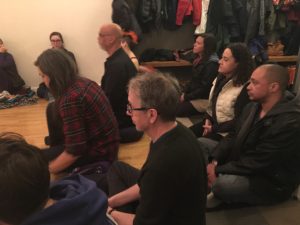Notes on a panel discussion held Sunday, January 22, 2017
By Renee Razzano
How is yoga a tool for social justice? What can the Iyengar yoga community do to improve access to and utilization of yoga, particularly for marginalized communities? One obstacle is this: that yoga has become, in the West, an endeavor largely undertaken by the most privileged persons. The stereotypical and commercialized image of a yoga student is slim, smiling, white, young, upper-class, educated, able-bodied, and cis-female. B.K.S. Iyengar pioneered an approach to yoga through which anyone, any body, may access the refuge, the tools, that are a yoga practice. This access, delivered through technical instructions, thoughtful sequencing, and creative and intelligent use of props, is a major hallmark of Iyengar yoga. Adeline Yoga has long striven to be a place where individuals of all cultural backgrounds can find their own internal space of refuge, beauty, and love through Iyengar yoga. How can this be further actualized? What can we do as individuals and as a community?
These are the questions that guided a recent community panel discussion at Adeline Yoga called “Yoga and Inclusivity.” Our panelists included Vivian Chávez, an associate professor at San Francisco State with a background in violence prevention, expressive arts, and community organizing; Jacqueline Shea Murphy, an associate professor in the Dance department UC Riverside whose work focuses on indigenous choreographers; and Sara M. Acevedo, a neurodivergent, mestiza, activist scholar, educator and disability justice advocate born and raised in Colombia, South America. About 35 people attended the event. After presentations, we gathered in smaller groups for deeper discussion and to brainstorm action items. Then we got back together to report out as a group and confirm our next steps.

The speakers all discussed the relationship between the spiritual elements of yoga and the concepts of healing and love. When yoga is reduced to a physical fitness activity, as it sometimes is here in the U.S., many layers of the practice are missing. Iyengar yoga places a strong emphasis on all eight of the limbs of yoga, including yamas and niyamas, which develop awareness and skillful action for the self and for the self in community with others, and the self in the ecological context of earth and cosmos.
Vivian began her talk with actions: she played music and laid out a number of items inside the circle – a painting by a local artist, a handmade textile, and candles to remind us all of sacred connections. I heard one of her main messages to be, “Love has something to do with social justice, and yoga has everything to do with love.” She also said that “the call for wisdom, devotion, and action is always within yoga.”
Jacqueline drew a parallel between restorative classes and restorative justice: in restorative classes, we aim to balance gunas (natural elements) and bring prana, or life-energy, back to the individual at the level of all of the kosas (or sheaths) of self. Similarly, restorative justice aims to balance resources, rights, and safety to the wider society, to re-energize the people.
Sara spoke about neurodiversity and disability justice, and the need for a yoga studio and teacher to cultivate sensitivity in order to work safely and effectively with a wide range of students. She described different ways of learning: that, for example, to simply repeat an instruction is often ineffective for those with certain learning styles. For some, it may be most effective for the teacher to address the student directly and visually show what to do specifically from where the student is, or to ask “May I show you?” before manually adjusting. For some individuals, particularly those with sensory sensitivities, or those who have experienced trauma, attempting a more communicative interaction in a class will create safety and more effective teaching.

Several people acknowledged the need to address racial justice in an urgent way. The group expressed a desire to learn more about sensitive interracial interaction, and wondered how to begin the process of including more people of color in the conversation, particularly members of the local community. Heather stated an intention to draw more people of color to the studio as students, so that they may develop into teachers and leaders in the Iyengar community. We also discussed the need to look introspectively at our culture, to see how we might be able to create a deeper cultural sensitivity and build individual and community partnerships in a way that expands the sense of inclusivity and welcome and safety for persons of all racial and ethnic backgrounds.
We finished the meeting with many excellent suggestions for next steps. Here are some of the main action items:
- Develop a free monthly yoga clinic for social activists at AYS. The clinic could involve a one-on-one session focusing on a specific aspect of practice that the activist-students wants to attend to. Another idea is to organize group practices that focus on specific topics that would be most useful for social activists, such as grief, anxiety, and trauma.
- Create or collaborate with a “yoga and whiteness” or “yoga and cultural awareness” discussion/training group
- Build partnerships with like-minded community organizations, and investigate collaborations and conversations with community organizations near to Adeline
- Create a volunteer-based inclusivity planning committee at AYS to help keep the ball rolling. The first meeting will be Sunday Feb the 12th from 6:30-8pm at the studio.
- Continue to use AYS as a platform for voices of marginalized peoples within and outside of the AYS community
As with all such efforts, we acknowledge our initial attempt was imperfect and limited in scope, as well as earnest, raw, and beautiful. The conversation will become richer, deeper, more inclusive, and more embodied as a greater proportion of us become interested and involved.
It is a long-term project. Many historical, personal, and social events led to this event, not least the recently elevated sense of urgency for the yoga community to become more aware and involved in matters of social justice. We will see change when we as teachers, students, and community members become more and more aware and take action to coax and develop change within ourselves and together.

Please join us Sunday Feb the 12th from 6:30-8pm at Adeline Yoga and stay tuned for other coming events!
In the meantime, check out this article from Gwi-Seok Hong about yoga and social justice, with a brilliant list of actionable ideas called “What Can You Do” and this article, “Black Health Matters,” from the New York Times.
To get involved, please send a message to info@adelineyogastudio.com.


Sara M. Acevedo says
This is so thoughtful and beautifully written! Thank you, Renee for mindfully captuting and representing our various approaches so well! With love, Sara M. Acevedo
Anonymous says
I agree! What a poetic rendering of our time together. I appreciate being part of the Adeline community to be/do yoga with all my heart, my full Self. -Vivian
Vivian Chavez says
I agree! What a poetic rendering of our time together. I appreciate being part of the Adeline community to be/do yoga with all my heart, my full Self. -Vivian